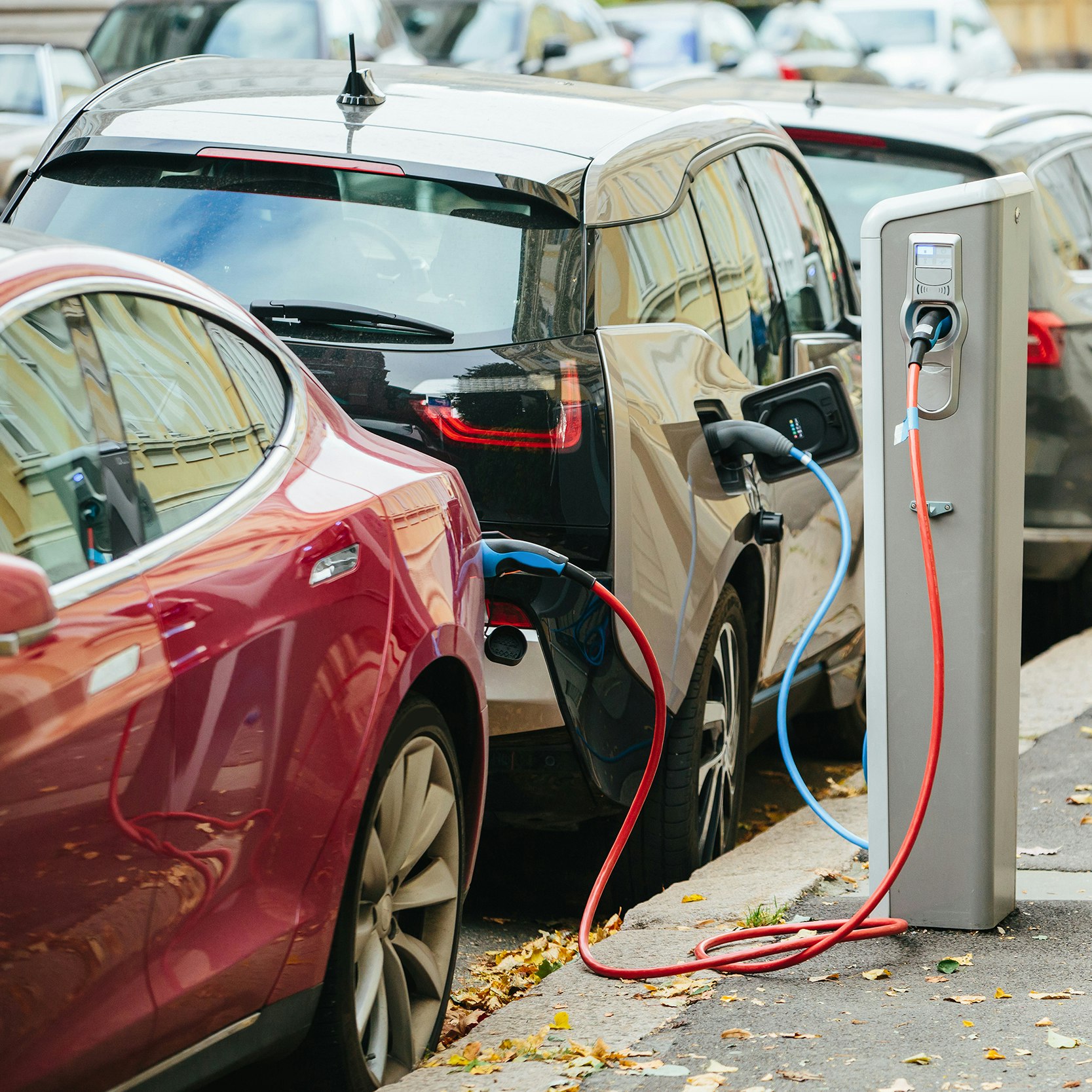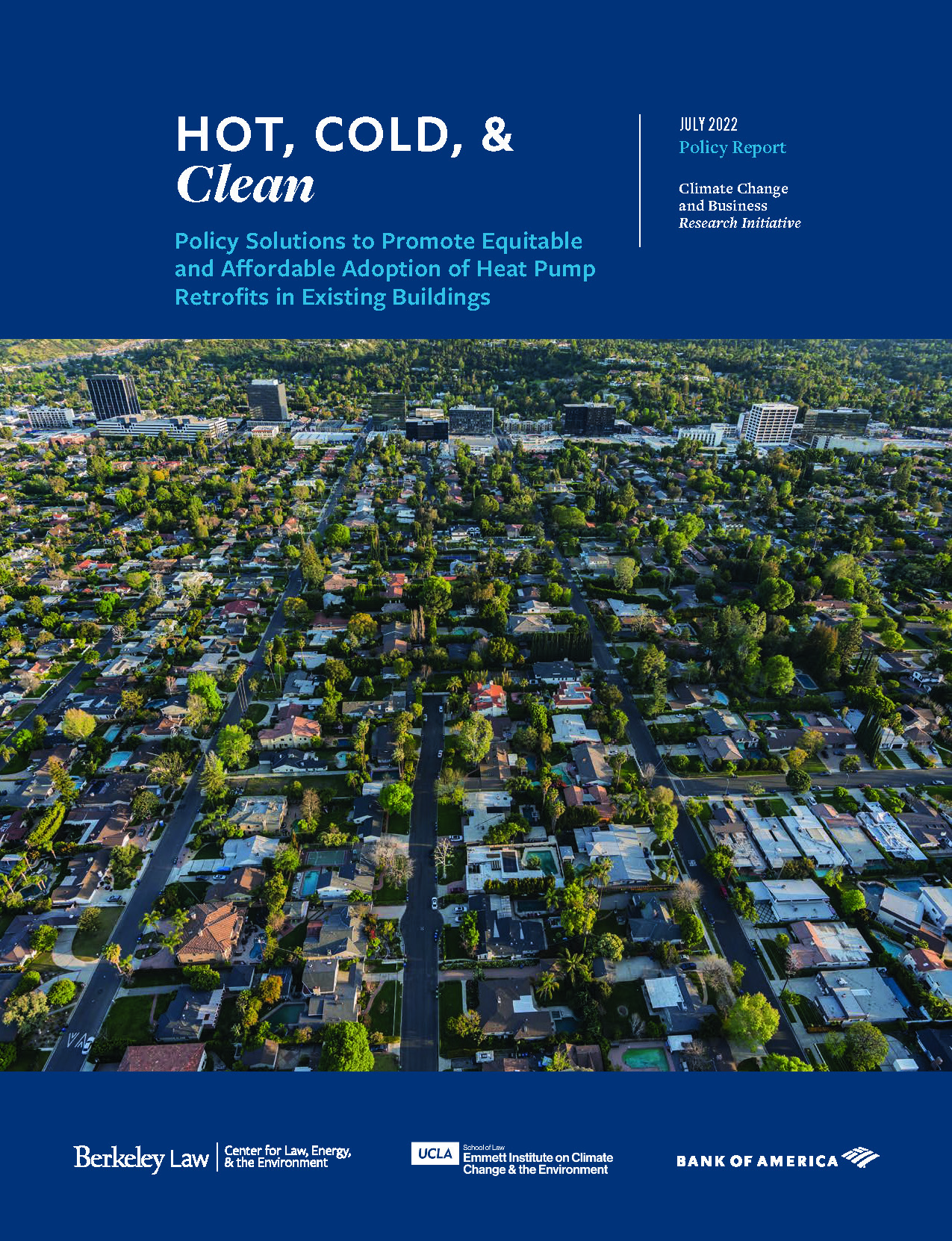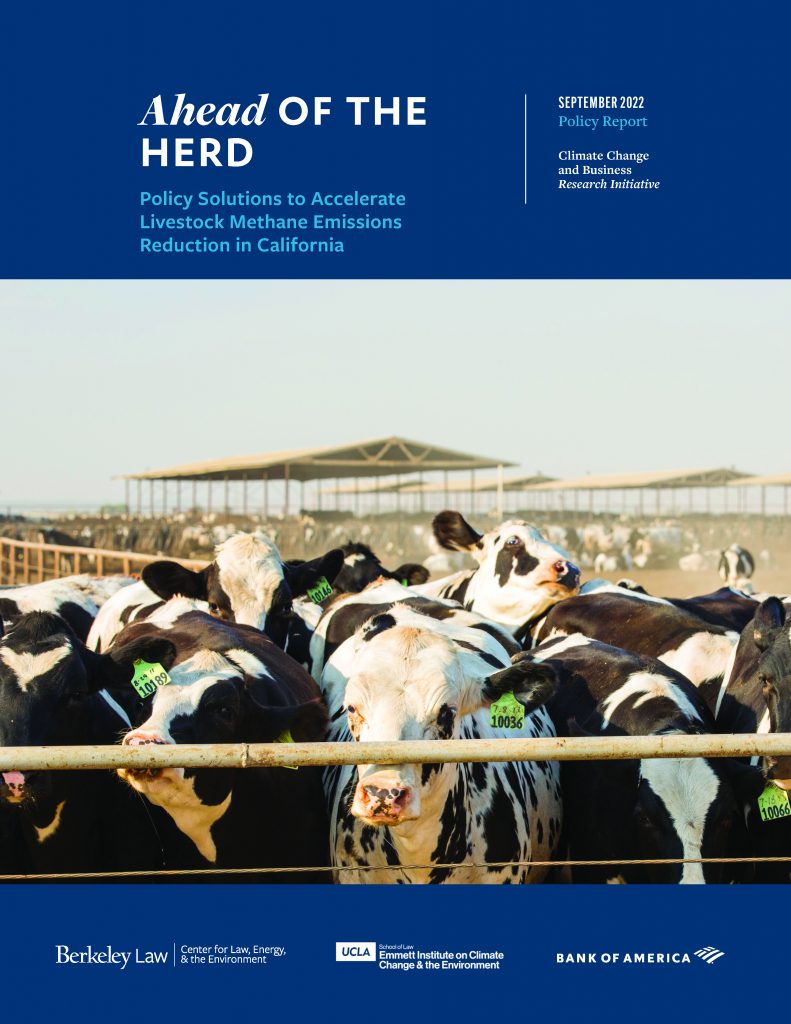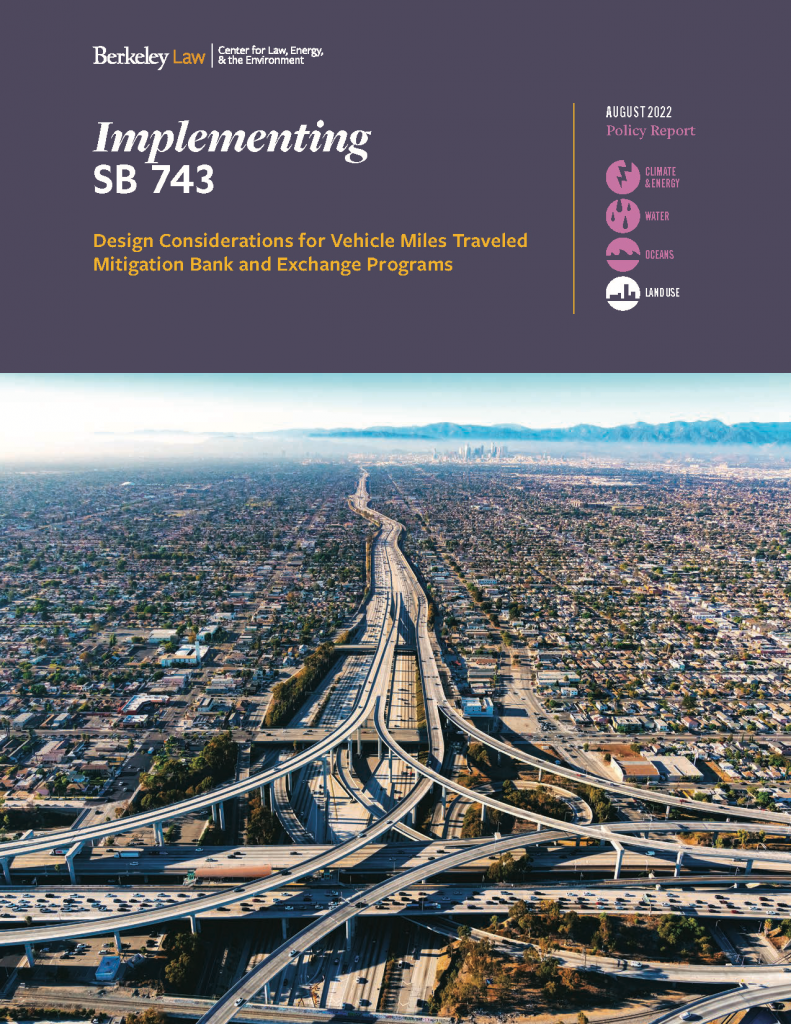Methane is a climate super-pollutant that is 80 times more powerful than carbon dioxide over a 20-year period. Given its potency and short life, experts believe that reducing methane emissions is the highest-yield action that governments and businesses can take to curb near-term warming.
In the US, livestock are responsible for over one third of anthropogenic methane emissions; in California, this number is over 50 percent, largely due to the state’s dairy sector, whose 1.7 million cattle produce nearly 20 percent of all US milk. State leaders have taken first-in-the-nation steps to address livestock emissions, but much work remains to achieve 2030 targets.
Our new report Ahead of the Herd from CLEE and UCLA’s Emmett Institute recommends several actions for state leaders to meet these targets while prioritizing environmental and public health:
- Create an interagency one-stop shop for greenhouse gas, air quality, water quality, and other data reporting and technical assistance
- Update the state’s Low-Carbon Fuel Standard to better assess the full life-cycle impacts and additionality of digester projects, support environmental health protections, and increase certainty for operators
- Accelerate approval of and increase financial support for new enteric emission reduction strategies
Livestock methane emissions stem from two oxygen-free (anaerobic) environments: the gut of animals, which produces enteric emissions in the form of burps; and liquid pools where manure is stored. (Worldwide, enteric emissions represent the majority of livestock methane, but in California the balance is closer to 50-50 due to the high prevalence of liquid manure storage at large-scale dairy operations.)
These two emissions sources call for two distinct sets of emissions reduction strategies. For manure emissions, the strategies include anaerobic dairy digesters that capture methane to generate energy or convert it into offsite fuels; and alternative manure management strategies that introduce oxygen into the waste storage process or filtering the waste through an ecosystem of hungry earthworms. For enteric emissions, the strategies include feed additives, diet modifications, vaccines, and breeding techniques that alter the chemistry of digestion to reduce methane generation.
California has developed a number of programs to reduce these emissions and as a result, according to the California Air Resources Board, has achieved a methane emissions reduction of over 3 million metric tons of CO2 equivalent since 2013. But the state is only on track to achieve about half of the 9 million metric ton reduction needed to achieve the 2030 target.
At the same time, dairy digesters—the leading emissions reduction strategy to date—are highly controversial. Neighboring communities and environmental justice advocates have serious concerns around the air and water quality impacts of large-scale, concentrated dairy operations—impacts that they argue are exacerbated by incentives for digesters. Industry leaders counter that facility concentration is driven by industry-wide economics rather than by digesters, and that digesters reduce certain air quality impacts compared to uncontrolled facilities.
To learn more about this issue and the report, RSVP here for our November 10th webinar, which will discuss the report and promising strategies to reduce livestock methane emissions, featuring:
- California Department of Food and Agriculture Secretary Karen Ross
- Ermias Kebreab of UC Davis
- Albert Straus of Straus Family Creamery
Download the Ahead of the Herd.
This post is co-authored by Ted Lamm.

It took a decade, but the California legislature has finally delivered to the governor one of the most critical climate and equity bills in the country. No, it’s not mandating carbon neutrality or increasing renewable energy. It’s finally ending local mandates that all new housing and infill projects must include car storage, even if they’re located within half-mile of transit.
AB 2097 (Friedman) builds on work dating back to 2011 (I blogged about then-Assm. Skinner’s failed attempt) to finally end parking requirements for projects near transit and with a percentage of affordable units. Otherwise, too many local governments have not gotten the memo that California’s climate and equity goals require more housing near transit and reduced need for residents to drive vehicles. Instead, many cities and counties still rely on outdated boilerplate planning requirements that require developers to build parking spots, even if residents don’t want or need them. The spots can run anywhere between $30,000 and $90,000 each to build, increasing the cost of housing and making it less affordable as a result.
So why would the state want to allow locals to mandate car storage? In the past, powerful anti-housing local governments resisted such a state override. But cities and counties have mostly lost that fight. Instead the entrenched interests are those that insist that eliminating these requirements will somehow harm the provision of affordable housing. And if it sounds counter-intuitive to you that making housing cheaper and not mandating car storage hurts affordability, it’s because it is.
Here’s the problem: in California, building new housing requires navigating an incredibly complex soup of state and local requirements. Some advocates for affordable housing use this byzantine system to extract concessions from developers. So if someone proposes relaxing one of these requirements, no matter how nonsensical or counter-productive to the environment and affordability it may be, these advocates will only support doing so if they can extract a concession for more affordable housing in the process.
An example is the state’s density bonus program, in which developers can add more density and reduce parking on a project beyond what the local governments allow, but only if they provide more subsidized affordable units. These advocates therefore worry that ending local parking requirements statewide will eliminate this incentive to build more affordable units.
While that might sound right in theory, in practice it’s not correct at all. Developers make money on increased density — more units on the same parcel. The parking reductions are only valuable in that they allow greater density to be built on the same limited parcel. Basically, developers only request the reduction in parking spaces if it means they can squeeze in extra units.
We’ve seen this in practice. As Mott Smith from USC and Michael Manville at UCLA have documented in multiple years and cities, including in the Los Angeles Transit-Oriented Communities (TOC) program, the evidence conclusively shows that reduced parking requirements lead to more affordable housing and does not undermine density bonus programs. Most prominently, in 2019, San Diego abolished parking requirements near transit for all housing projects (which is precisely what AB 2097 would accomplish statewide), and the results were decisive: overall housing units increased 24%, density bonus units increased five-fold, and deed-restricted affordable units via density bonuses increased six-fold.
The evidence is clear. California is behind on meeting its 2030 climate goals, and much of the culprit is due to rising transportation emissions from more driving. We also face a brutal housing shortage, leading to a mass exodus of residents to high-polluting states, pervasive homelessness, and stark income inequalities. AB 2097 would knit a solution to both problems, by making housing more affordable and reducing the need to own a car right near existing transit hubs.
After a decade of waiting, the state’s residents need this crucial reform to abolish car storage mandates. Let’s hope Governor Newsom does the right thing and signs AB 2097.

I’ll be a guest on today’s KQED Forum at 10am PT, discussing California’s plans to phase out sales of new gas-powered cars by 2035. The new regulations announced last week by the California Air Resource Board formalize Governor Gavin Newsom’s 2020 executive order which proposed banning the sale of cars that run on fossil fuels.
This move is a much-needed step to address climate change. The show will cover what it means for the world’s fifth largest economy and the state that invented car culture to go electric, and they’ll open it up to listener questions: are you ready to get an electric car or will you be hanging on to your gas-powered car as long as you can?
Joining me on the panel will be:
- Russ Mitchell, Automotive Editor for the Los Angeles Times
- Margo Oge, Former director, US EPA Office of Transportation and Air Quality; Author of “Driving the Future: Combating Climate Change with Cleaner, Smarter Cars”
You can stream it live or tune in via KQED in the San Francisco Bay Area!

Last week, California regulators approved a first-in-the-nation plan to ban the sale of new gas-powered vehicles starting in 2035. Tonight on State of the Bay, we’ll discuss the new regulations with Liane Randoph, chair of the California Air Resources Board, the agency responsible for implementing the plan.
Then we’ll talk about the little-known Minerva University in San Francisco, which recently knocked MIT out of first place for the “most Innovative university in the world.” Joining us will be Mike Magee, President of Minerva University.
Finally, we’ll speak with Nicole Meldahl, executive director of the Western Neighborhoods Project, about a slice of San Francisco history.
What would you like to ask our guests? Post a comment here, tweet us @StateofBay, send an email to stateofthebay@kalw.org or leave a voicemail at (415) 580-0718.
Tune in tonight at 6pm PT on KALW 91.7 FM in the San Francisco Bay Area or stream live. You can also call 866-798-TALK with questions during the show.

Today on Your Call’s Media Roundtable, I’ll be guest hosting a discussion about Wyoming Republican Rep. Liz Cheney’s primary loss on Tuesday, as well as her record in Congress. Cheney and seven other House Republicans who voted to impeach Trump have now either lost primary races or are retiring from Congress. What does this mean for the future of the Republican Party and our upcoming elections? Joining us will be:
- John Nichols, the national-affairs correspondent for The Nation and author of several books, including The Fight for the Soul of the Democratic Party: The Enduring Legacy of Henry Wallace’s Anti-Fascist, Anti-Racist Politics.
Later in the program, we’ll talk about the new PBS Frontline documentary Afghanistan Undercover, which details the plight of women in Afghanistan and their struggle for gender equality. Correspondent Ramita Navai will talk about how she was able to report this story and the latest on women’s status in that country.
Tune in at 91.7 FM in the San Francisco Bay Area or stream live at 10am PT. What comments or questions do you have for our guests? Call 866-798-TALK to join the conversation!
When California state agencies and other local leaders build or approve projects that increase overall driving miles, state law requires them to mitigate those impacts. A new report from CLEE describes how these agencies can reduce vehicle miles traveled (VMT) by investing in offsite options like bike lanes, bus-only lanes, transit passes, and other measures that can effectively and efficiently reduce a corresponding amount of VMT.
Under the California Environmental Quality Act (CEQA), government agencies and developers are required to mitigate (where feasible) the significant environmental impacts of new projects subject to discretionary approval, including impacts to transportation.
Senate Bill 743, originally enacted in 2013, called for a new transportation impact measure that promotes greenhouse gas (GHG) emission reduction and multimodal transportation. In 2018 state leaders updated the CEQA guidelines to recommend VMT as the preferred impact measurement. VMT focuses on total vehicle trip-miles generated by a new project regardless of where they occur or how much traffic they cause.
Mitigating VMT impacts of new projects has the potential to shift California’s development patterns in a more sustainable, transit-oriented direction. It also creates the opportunity—and potentially the need—to conduct mitigation at locations other than the development site when onsite mitigation is not possible or practical. Such offsite mitigation can address the regional and statewide nature of VMT impacts in the most efficient and cost-effective locations, particularly when mitigation might prove difficult at the site of a suburban or exurban development.
If properly conducted, offsite mitigation could maximize flexible and locally appropriate transit, active transportation, and density investments. But to carry it out, state and local government leaders will need new frameworks to track mitigation obligations, plan investments, and facilitate transactions. CLEE and others have previously proposed “bank” and “exchange” programs to manage these capacities.
CLEE’s new report, Implementing SB 743: Design Considerations for Vehicle Miles Traveled Bank and Exchange Programs advances these proposals with a set of strategies for state agencies like Caltrans (the state agency most likely to be responsible for VMT-inducing projects) and local governments to develop bank and exchange programs that build on their existing environmental mitigation efforts. In addition to analyzing the legal and programmatic setting for VMT mitigation banks and exchanges, the report offers a set of recommendations for policymakers including:
- A state-level program for state agencies to manage mitigation and select locally appropriate investments, likely based on collaboration between Caltrans and other state transportation and land use agencies
- Regional-level programs for local and regional agencies to manage mitigation flexibly and efficiently within appropriate geographic limitations—likely managed by Metropolitan Planning Organizations or Regional Transportation Planning Agencies, but potentially run by large cities or counties in some cases
- Frameworks for analyzing the “additionality” of VMT mitigation investments to ensure that bank and exchange program funds support VMT reductions beyond those that would have occurred anyway
- Strategies for defining equity in the context of VMT mitigation and integrating equity into the decision-making of a bank or exchange program
Cities and counties around the state, from San José to San Diego, are in the process of developing their own approaches that could become, or could integrate into, VMT banks and exchanges. Caltrans and local government leaders will require significant time and resources to develop programs that fit the nature of the VMT-inducing projects they oversee and the needs and priorities of the areas they represent—and many questions remain, from prioritizing different mitigation investments to ensuring those investments are made in an equitable fashion. The strategies outlined in the report should help inform these decisions and advance the VMT reduction efforts initiated by the legislature nearly a decade ago.
This post was originally co-authored by Ted Lamm and Katie Segal on Legal Planet.

It’s another double shot today of me hosting shows on KALW 91.7 FM San Francisco Bay Area. First, at 10am PT, I’ll be guest hosting Your Call’s One Planet Series, where we’ll discuss the viability of carbon capture technology in combating climate change. Carbon capture and storage is the process of capturing and storing carbon dioxide from polluting sources and storing it deep in the ground.
The just-passed (but not yet signed) Inflation Reduction Act includes a change in a crucial tax credit for the carbon capture industry—increasing the government subsidy for capturing CO2 from polluting sources from $50 to $85 per metric ton.
Some environmentalists call these carbon capture subsidies a handout to the oil industry and a distraction from urgently needed actions. How effective is this technology? Joining us to discuss are:
Tony Briscoe, environmental reporter with the Los Angeles Times
Naomi Oreskes, Henry Charles Lea Professor of the History of Science and Affiliated Professor of Earth and Planetary Sciences at Harvard University.
Then we’ll cover the socio-environmental impacts of lithium mining to produce electric vehicles. Joining us will be Jennifer Krill, executive director of Earthworks, a nonprofit organization committed to protecting communities from the adverse impacts of oil and gas and mineral extraction.
Second, later today on State of the Bay at 6pm PT, we’ll cover the latest in San Francisco’s housing saga, as the state threatens to take over land use planning for the City. Plus we’ll discuss the rise of autoimmune disorders and learn about California’s youth governor’s race, covered in a new documentary.
Tune in at 91.7 FM in the San Francisco Bay Area or stream live at 10am PT for Your Call and then again at 6pm PT for State of the Bay. What comments or questions do you have for our guests? Call 866-798-TALK to join the conversation!
Californians would greatly benefit from fast, electrified high speed rail. But the system currently under construction is badly behind schedule and lacks funding to finish. It’s a warning to the rest of the country about our ability to build big, climate-friendly infrastructure.
Vox.com produced a video describing the challenges, featuring some words from yours truly:
/cdn.vox-cdn.com/uploads/chorus_image/image/70891865/ht1.0.jpg)
Tonight on State of the Bay, we’ll get the latest on the Oakland Athletics’ bid for a new waterfront ballpark at Howard Terminal. Or will the A’s be moving to Las Vegas after all? Joining us for the latest will be Steve Berman, staff writer for the Athletic.
Plus, we’ll speak with Elizabeth Funk, founder and CEO of DignityMoves, about her community of temporary homes that could be an important part of the solution to homelessness.
Finally, we’ll hear from Michael Goldberg about his new book Wicked Game, a biography of guitarist Jimmy Wilsey.
Tune in tonight at 6pm PT on KALW 91.7 FM in the San Francisco Bay Area or stream live!

This post is co-authored by Ross Zelen.
As California and other leading climate jurisdictions move toward all-electric buildings, replacing older gas-powered furnaces and air conditioning units with heat pumps can reduce carbon emissions and indoor air pollution while increasing efficiency, comfort and resiliency, especially as extreme heat events increase. Heat pumps are a highly efficient technology that provides all-electric space and water heating and cooling, acting essentially as a two-way air conditioner.
Today, the Center for Law, Energy and the Environment (CLEE) at Berkeley Law and the Emmett Institute on Climate Change and the Environment at UCLA Law are releasing a new report, Hot, Cold, & Clean: Policy Solutions to Promote Equitable and Affordable Adoption of Heat Pump Retrofits in Existing Buildings, which highlights key policy solutions to ensure that California’s push to decarbonize existing homes and buildings will support equitable deployment of electric heat pumps.
Top-priority strategies include setting a clear phaseout timeline for natural gas space and water heaters, protecting low-income tenants from inadvertent rent increases or increased utility costs, and supporting “high road” job training programs to turn heating, ventilation and air conditioning (HVAC) installers and contractors into heat pump champions.
The stakes are high: California’s residential and commercial building sector accounts for nearly a quarter of the state’s greenhouse gas emissions and combustion of fuel for heating and cooling buildings generates more than 10 percent of state emissions. Electric heat pumps provide a deployable solution to reduce emissions from furnaces, water heaters, and other building appliances. To achieve state goals of 40 percent greenhouse gas emission reduction (below 1990 levels) by 2030 and carbon neutrality by 2045, California must significantly reduce emissions from the built environment.
Earlier this year, the California Energy Commission set out an ambitious target of deploying 6 million heat pumps by 2030. With more than 14 million existing residential homes in the state, more than 75 percent of California’s existing buildings built before 1978, and heat pumps installed in only 6 percent of new construction, the state has a long way to go to meet its goals.
Hot, Cold, & Clean is based on a convening of state, local, utility, housing and environmental leaders aiming to identify point-of-purchase, installation, and financing challenges that stymie heat pump deployment. The report captures the progress since our 2021 report Building toward Decarbonization and identifies additional policy solutions to overcome remaining barriers. For example, state leaders could:
- Set a clear timeline for the long-term phaseout of natural gas space and water heaters to provide certainty for utilities, homeowners, tenants and investors.
- Set zero-emission air quality standards for space and water heaters to make heat pumps the baseline technology.
- Enhance funding for low-income homeowners and affordable housing providers to improve electrical infrastructure to facilitate heat pump deployment, in a manner that prevents displacement and rent increases.
- Scale educational models and training programs for high road installer, maintenance, contractor and electrician positions and financially support deployment through midstream incentives for heat pump installations
This is not only a California issue. At the federal level, heat pumps have been recognized as a key technology to reduce reliance on fossil gas. On June 6, President Biden invoked the Defense Production Act (DPA) to rapidly expand domestic manufacturing of heat pumps to reduce building energy use and reduce U.S. reliance on oil and fossil gas. Current domestic U.S. HVAC manufacturing suppliers are not producing heat pumps at the rate needed. Additionally, the Department of Energy announced the first major update on gas-burning furnaces in 30 years, spurring more homes to move to heat pump solutions or adopt more efficient units. These actions should help address key barriers discussed in the report, such as the lack of heat pump supply and the need for increased manufacturer focus on educational workforce training.
To learn more, please join us next Tuesday, July 19 at 1:00 PM PT for a webinar to discuss the report and equitable heat pump deployment, featuring:
- Commissioner Andrew McAllister of the California Energy Commission
- Chelsea Kirk of Strategic Actions for a Just Economy (SAJE)
- Jose Torres of the Building Decarbonization Coalition.




